
Do you find it hard to sleep at night? Yoga can offer some relief from all the restlessness you experience when you lie down so you can get to sleep quickly and enjoy a good night’s rest.
Yoga is a form of physical exercise that brings peace and control to the practitioner’s mind and body. This results in improved mental health, lowered stress levels, and a boost to overall well-being. Yoga is an excellent way to help prevent insomnia, promote deep relaxation, and foster longer, deeper, and better quality of sleep.
Many people worldwide practice yoga to promote inner peace and overall wellness. A staggering 85% of people who practiced yoga reported to have reduced stress and over 55% of people who practiced yoga experienced improved sleep.
What is Yoga?
Yoga is the practice of different breathing techniques, body postures, meditation, and relaxation. It originated in India and has been practiced for over 5000 years. Today, there are at least 17 different disciplines or types of yoga that are practiced all over the world.
The two disciples that have shown to be the most successful at helping promote better sleep are Hatha Yoga and Yoga Nidra.
Hatha Yoga is perfect if you are just starting to participate in yoga. It’s very slow-paced and covers the basics of Yoga, concentrating on controlled movements, and stretches which help you to elevate the sleep hormone serotonin in your body.
The other great yoga option for better sleep is Nidra yoga. It’s based around meditation and the experience of different stages of consciousness such as waking, dream, and dreamless deep sleep. Nidra Yoga encourages the highest sense of relaxation while remaining connected to the present.
Combining these two types of yoga creates optimal balance within the body for a better night’s sleep.
Benefits of Yoga on the Body
Yoga does more for our bodies than just improve the quality of our sleep. Yoga teaches us to have discipline.
When we have discipline in our minds and take control of our thoughts and body processes, we are teaching ourselves how to become calmer and focused. With calm and focus come lower levels of cortisol, the stress hormone that can damage our health if stress levels are too high for long periods of time. In fact, yoga has such a calming effect that some people experience the same relief they normally get from an antidepressant.
Yoga also helps reduce anxiety and promote self-healing. Practicing yoga can reduce inflammation which if not treated could result in diseases like diabetes, heart diseases, and even certain types of cancer. Yoga can help lower blood pressure, prevent heart attacks, and slow down the progression of heart diseases.
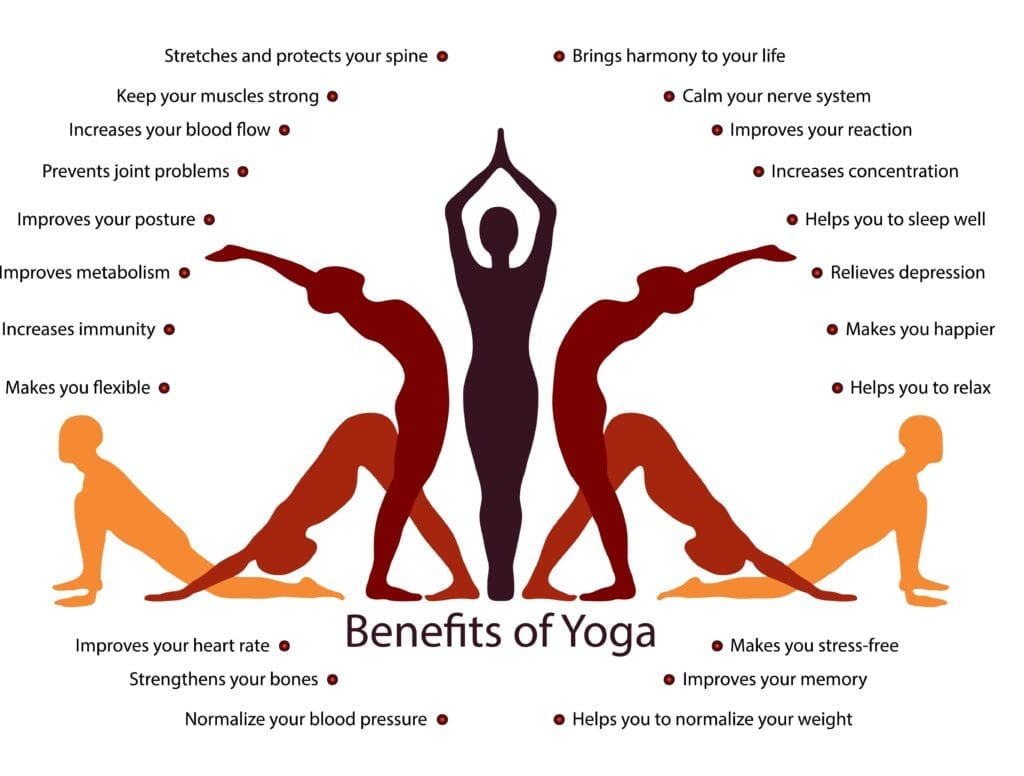
How does Yoga Lead to Better Sleep?
There has been a significant amount of research and studies linking yoga and better sleep. A study done by Marlylynn Wei though Harvard Health found that over 55% of people who regularly participated in yoga got better sleep, and over 85% said that yoga had reduced stress. Wei says practicing yoga poses such as the wide-knee child pose, legs up the wall, corpse pose, and others, for 3 to 5 minutes before bed can lead to better sleep.
Another study published by The National Sleep Foundation confirmed that yoga is beneficial for people as they get older and for pregnant women. The study warns that some types of yoga are very energizing like hot yoga or a vigorous vinyasa style. These types of yoga are great during the day but should be avoided at night to promote sleep. Hatha and Nidra yoga are the right types of yoga to help you fall asleep fast. This is especially true if you use the Legs Up the Wall, Lying Butterfly, and Corpse Poses to prepare your body for sleep.
A third study from Johns Hopkins shows that Hatha Yoga and Nidra Yoga are best for improving sleep because Hatha yoga concentrates on body position while Nidra yoga focuses on breathing and restorative poses. These two types of yoga, when done together, significantly improving sleep quality.
The study from Johns Hopkins also explained the importance of being in the right atmosphere or setting. This along with practicing proper breathing during yoga poses makes a world of difference when it is getting a better night’s rest.
Top 9 yoga poses for better sleep
The following are 9 poses one may try for better sleep and simple instructions on how to achieve each pose:
Hero Pose (Virasana)

Kneel and part your feet wider than your hips, with the tops of your feet flat on the floor. Exhale and position your torso slightly forward as you sit your hips back between your feet. Place your hands with palms down on top of your thighs.
Sit straight and tall. The crown of your head should point to the ceiling and looks straight ahead. Breathe normally and remain in this pose for 60 seconds.
Child’s Pose (Balasana)
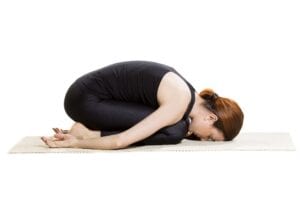
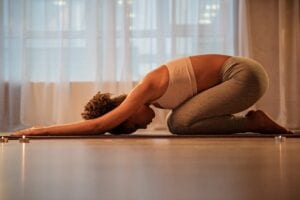
Kneel with your knees slightly wider than your hips and with your toes together. Breathe out while slowly lowering your torso between your knees. Stretch out your arms alongside your torso with your palms facing down.
Alternatively, you can bring the arms back along the sides of the thighs with the palms facing up, as shown in the photos. Remain in the pose for 2 to 3 minutes.
Upward Dog (Urdhva Mukha Svanasana)

Lie face-down and extend your legs behind you. Spread your legs slightly apart. With your hands placed alongside your body next to your lower ribs, breathe in as you slowly straighten your arms. At the same time, slowly elevate your torso and your legs a few inches off the floor. Press through your hands firmly into the floor and hold this pose for a couple of minutes.
Camel Pose (Ustrasana)
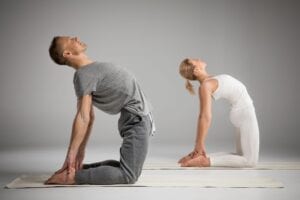
Starting in an upright kneeling position with your knees apart, press your shins and your feet into the floor. Push your lower belly in and up. Roll your shoulders back. Breathing out, lean back into a backbend. Touch your heels with your hands. Remain in this pose for a couple of breaths. Breathe in as you come back up to sit on your heels.
Supine Twist (Supta Matsyendrasana)
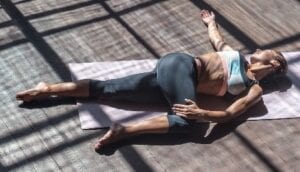
Lying supine, bend your knees. Plant your feet planted firmly on the floor and point your knees up towards the ceiling. Press into your feet to bring your hips a bit off the floor and shift them slightly to your right. Breathe out and bring your right knee into your chest and bring your left leg into a flexed position. Breathe in.
Now breathe out as you bring your right knee to cross over your midline to the left side of your body. Your right hip is now stacked on top of your left hip. Rest your left hand on your right knee.
Stretch out your right arm to the right, keeping it in line with your shoulders. Face the palms of your hands toward the ceiling. Turn your head towards the right, with your eyes focussed on your right fingertips. Hold the pose for five to 10 breaths. Repeat the steps for the other side.
Bridge (Setu Bandha Sarvangasana)
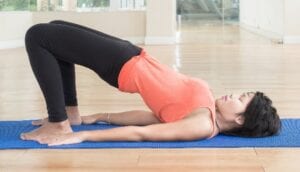
While lying supine with your knees bent and feet on the floor, straighten your arms along the floor with your palms flat, and your feet and arms pressed firmly into the floor. Breathe out as you lift your hips off the floor.
Gently and slowly rotate your shoulders back and beneath your body. Hold your hands together and stretch out your arms on the floor underneath your pelvis. Your thighs and feet should be parallel and your weight pressed evenly across both feet.
Maintain this pose for 30 seconds. To release, place your hands with your palms facing down along the side of your body. Breathe out while you gradually and gently have your spine roll along the floor, vertebra by vertebra.
Knee to Chest (Apanasana)

Lie on your back. Extend your arms and legs. As you slowly breathe out, bring both of your knees to your chest while maintaining your back flat on the floor. Clasp both hands around your legs. Gently tuck in your chin and look down the midline of your body. Hold for 60 seconds. Slowly breathe out, while releasing and stretching out both legs along the floor.
Corpse Pose (Savasana)
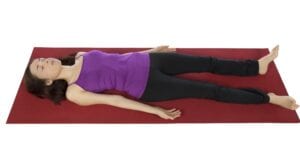
Lie on your back. Bring your knees in towards your chest and clasp both legs with your hands, and breathe in deeply. Breathe out while extending your legs out away and keeping your tailbone on the floor. Place both feet hips-width apart and away from each other. Relax your lower back and your shoulders. Place your arms alongside your body, with your palms facing upward.
Butterfly Pose (Baddha Konasana)
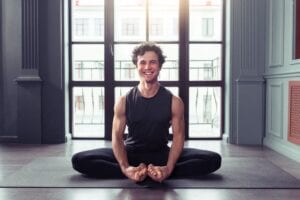
Seated on the floor, extend your legs with your feet together. Keeping your head, neck, and spine straight, bend your legs at the knee and bring your feet closer to the body. Bring your feet close together, facing the soles squarely against each other. Bring the paired feet closer to the groin.
Keeping your back as straight as possible, gently grasp your feet. Maintain this pose for 60 seconds. Gently extend the legs and relax.
These are the top 9 poses that are suggested to be the best for improving sleep. There are many others that are also beneficial so find ones that you enjoy the most and practice those poses during your daily yoga routine.
Practise these simple poses prior to bedtime and, together with good sleep hygiene, a more restful night’s sleep is just a few moments away!
How to start doing yoga
 Yoga is one of the few physical activities that has no real restrictions. Yoga is something that anyone can do no matter your age, gender, or body type. Yoga basics are perfect for beginners at any fitness level. Getting started can be as easy as following along with a YouTube video or on Amazon. However, it can be more fun to do yoga in a group and it’s great to have an instructor to ask questions when you’re just getting started.
Yoga is one of the few physical activities that has no real restrictions. Yoga is something that anyone can do no matter your age, gender, or body type. Yoga basics are perfect for beginners at any fitness level. Getting started can be as easy as following along with a YouTube video or on Amazon. However, it can be more fun to do yoga in a group and it’s great to have an instructor to ask questions when you’re just getting started.
Try to perform the poses to the best of your best ability. Don’t compare yourself to the person next to you because they might already have years of practice. Know that almost every pose offers modifications for people who aren’t flexible enough yet or are recovering from an injury. Also, certain poses may cause some discomfort as your muscles and tendons stretch, but it should never hurt. Feel free to back out of a pose if it isn’t working for you at any time during your practice.
Safety and Precautions
If you have any medical concerns, talk with your doctor before practicing yoga. While yoga is generally safe in healthy people, you should consult your doctor if you are pregnant, have balance problems, had surgery, spinal, hip, or knee injury, arthritis, a joint replacement, high blood pressure, or other health issues. Always work within your own range of limits and abilities.
Conclusion
The practice of yoga has deep roots in helping people increase their physical strength, mental energy, and spiritual vitality. It is an incredibly effective way to create calm and deep relaxation, and promote peace in your life in a way few other activities can.
The benefits of yoga are needed more than ever today because of the fast-paced, always-turned on, 24-hour world we live in. A simple yoga practice – whether it is for sleep, insomnia, or deep relaxation – might be one of the best things you can do for yourself. Best of all, with just a few minutes of yoga a day, you can do wonders for your physical, mental, and spiritual health along with better night’s sleep!
It’s always a good idea to check with your doctor before you start any exercise program, particularly if you have any injuries or medical conditions, are over the age of 65, or are out of shape.

4 Responses
I didn’t think yoga would be so helpful but I was wrong. I’ve just recently started incorporating it into my almost daily routine and it has changed the way I feel and sleep. I do yoga with Adriene as I find her easy to follow. I highly recommend yoga to anyone if they want a better sleep and a better body.
We are glad for you, Denise, that you have taken up yoga, and found the right yoga teacher, and that she is helping you reap the benefits of yoga, improving the way you feel and sleep.
There are many excellent online yoga classes that allow you to practice where you are, when you want, and as you are, such as Yoga with Adriene (which you have kindly recommended), Man Flow Yoga, and Yoga Download.
For me, the supine twist is very difficult at the moment. I don’t have good mobility and this is hard to do. I’m doing my best to gain mobility but it will be some time before I can actually do this move (and others) the right way. But, progress is what I’m looking for.
Always listen to your body and know what you can give. Only go as far as your body feels comfortable. Never force your body to do something it is not ready to do.
Don’t do too much too quickly. Go at your own pace. Like any other form of physical activity, asking the body to do more than it’s capable of can result in pain, discomfort, and even injury. If a pose starts to feel too uncomfortable or painful, immediately release the pose.
The supine pose that you are practicing now probably requires you to move your body in ways you probably haven’t before. As you gain flexibility, you can gradually and progressively work towards the pose or hold the pose for longer. With time and regular practice, holding the yoga pose should get easier.
Until then, ask your yoga instructor for modified postures.
Some possible modifications that simplify this yoga pose (supine twist) can help you.
• If you may feel like you can not lower your right knee to the floor while keeping both shoulders flat on the ground, keep the shoulders flat on the ground and allow your knee float up a little bit.
• If your right knee is raised way up from the floor, place a block or a blanket under it for support.
• If you feel that having one leg bent and the other leg straight feels too uncomfortable, bend both your legs at the knees and stack them.
Almost every yoga pose offers modifications for people who aren’t flexible enough yet. Some yoga poses can cause some discomfort, but never pain, as your tendons and muscles stretch. Back out of a pose if it isn’t working for you at any time during your practice.
Or, try another yoga pose that works for you, one that allows you to feel relaxed and to be pain-free. Hopefully, your yoga practice before bed is soothing, calms your mind, allows you to be in tune with your body, relieves tension in your body for a good night’s sleep!